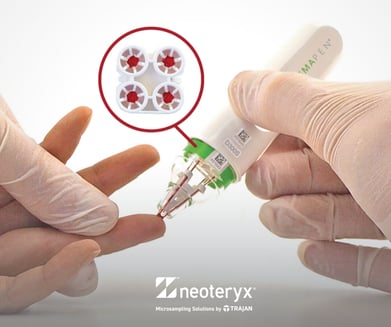Share this
vitamin d blood biomarkers: a brief introduction
by Neoteryx Microsampling on Sep 3, 2019 3:01:00 AM
 Vitamin D acts as an essential enhancer of phosphate and calcium homeostasis. Scientists are familiar with the role the hormone plays in the formation and maintenance of strong bones and teeth in vertebrates. As a hormone, it can be synthesized by the skin after prolonged exposure to sunlight. It is also obtained from a wide variety of animal products such as eggs, cheese, and milk.
Vitamin D acts as an essential enhancer of phosphate and calcium homeostasis. Scientists are familiar with the role the hormone plays in the formation and maintenance of strong bones and teeth in vertebrates. As a hormone, it can be synthesized by the skin after prolonged exposure to sunlight. It is also obtained from a wide variety of animal products such as eggs, cheese, and milk.
Lack of hormones causes various deficiencies such as rickets. You cannot easily diagnose its lack without testing for its biomarkers. There are different biomarkers, all of which have atypical actions in the body for which you can test.
How many biomarkers are known?
Out of the more than 50 known Vitamin D metabolites, only a few have been quantified scientifically. As scientists continue to widen the scope of study in this subject, surprising findings have been documented. Some of them include:
- The other roles played by the predominant and active form of Vitamin D in the body, which is dihydroxy vitamin D3 [1,25(OH)(2)D3]. A recent study indicates this biomarker – besides controlling calcium and phosphate – regulates the genes that control cell protein-coding, cell differentiation, and cell proliferation.
- Another biomarker, 25-hydroxyvitamin D3 [(OH)(D3)] has been found to influence cancer, cardiovascular disorder, the immune system and its associated disorders.
In the general population, these studies are essential, and Vitamin D sampling in individual and population settings allows scientists to estimate its total supply. Since Vitamin D deficiency is a widespread public health concern, sampling allows scientists to recommend the action needed for various population groups. For example, infants, children, specific ethnicities, and women of reproductive age require different active Vitamin D biomarkers.
Consistent patient monitoring is required to fully document the presence of various biomarkers in different individuals. Previously, this required either home doctor visits or having patients visit a clinic.
A Few Drops of Blood on a Microsampling Device Enable Vitamin Analysis in the Lab
Remote microsampling is a novel alternative that opens new pathways of care, including monitoring of vitamins. It allows patients to collect blood samples at home so research scientists, doctors and other healthcare professionals can easily monitor their health and wellness.
The application of this smarter healthcare technology allows for unprecedented flexibility in monitoring of patients and study cohorts.
 Finger-stick blood sampling at home is a huge improvement over traditional blood sampling methods, which required people to visit a hospital, lab or clinic for blood tests. The remote microsampling trend is making way for new innovations and cost savings and an improved end-user experience.
Finger-stick blood sampling at home is a huge improvement over traditional blood sampling methods, which required people to visit a hospital, lab or clinic for blood tests. The remote microsampling trend is making way for new innovations and cost savings and an improved end-user experience.
A remote microsampling device like the hemaPEN® offers a convenient and portable approach to sample collection from a single finger-stick with a lancet. The hemaPEN technology combines capillary sampling with dried blood spot (DBS) sampling in one device. Learn how every hemaPEN delivers 4 precise DBS samples to the lab here and learn how to analyze hemaPEN DBS samples once they arrive in the lab, here.
Share this
- Microsampling (206)
- Research, Remote Research (119)
- Venipuncture Alternative (105)
- Clinical Trials, Clinical Research (83)
- Mitra® Device (73)
- Therapeutic Drug Monitoring, TDM (51)
- Dried Blood Spot, DBS (39)
- Biomonitoring, Health, Wellness (30)
- Infectious Disease, Vaccines, COVID-19 (24)
- Blood Microsampling, Serology (23)
- Omics, Multi-Omics (21)
- Decentralized Clinical Trial (DCT) (20)
- Specimen Collection (18)
- Toxicology, Doping, Drug/Alcohol Monitoring, PEth (17)
- Skin Microsampling, Microbiopsy (14)
- hemaPEN® Device (13)
- Preclinical Research, Animal Studies (12)
- Pharmaceuticals, Drug Development (9)
- Harpera Device (7)
- Industry News, Microsampling News (5)
- Antibodies, MAbs (3)
- Company Press Release, Product Press Release (3)
- Environmental Toxins, Exposures (1)
- July 2025 (1)
- May 2025 (1)
- April 2025 (2)
- December 2024 (2)
- November 2024 (1)
- October 2024 (3)
- September 2024 (1)
- June 2024 (1)
- May 2024 (1)
- April 2024 (4)
- March 2024 (1)
- February 2024 (2)
- January 2024 (4)
- December 2023 (3)
- November 2023 (3)
- October 2023 (3)
- September 2023 (3)
- July 2023 (3)
- June 2023 (2)
- April 2023 (2)
- March 2023 (2)
- February 2023 (2)
- January 2023 (3)
- December 2022 (2)
- November 2022 (3)
- October 2022 (4)
- September 2022 (3)
- August 2022 (5)
- July 2022 (2)
- June 2022 (2)
- May 2022 (4)
- April 2022 (3)
- March 2022 (3)
- February 2022 (4)
- January 2022 (5)
- December 2021 (3)
- November 2021 (5)
- October 2021 (3)
- September 2021 (3)
- August 2021 (4)
- July 2021 (4)
- June 2021 (4)
- May 2021 (4)
- April 2021 (3)
- March 2021 (5)
- February 2021 (4)
- January 2021 (4)
- December 2020 (3)
- November 2020 (5)
- October 2020 (4)
- September 2020 (3)
- August 2020 (3)
- July 2020 (6)
- June 2020 (4)
- May 2020 (4)
- April 2020 (3)
- March 2020 (6)
- February 2020 (3)
- January 2020 (4)
- December 2019 (5)
- November 2019 (4)
- October 2019 (2)
- September 2019 (4)
- August 2019 (4)
- July 2019 (3)
- June 2019 (7)
- May 2019 (6)
- April 2019 (5)
- March 2019 (6)
- February 2019 (5)
- January 2019 (8)
- December 2018 (3)
- November 2018 (4)
- October 2018 (7)
- September 2018 (6)
- August 2018 (5)
- July 2018 (8)
- June 2018 (6)
- May 2018 (5)
- April 2018 (6)
- March 2018 (4)
- February 2018 (6)
- January 2018 (4)
- December 2017 (2)
- November 2017 (3)
- October 2017 (2)
- September 2017 (4)
- August 2017 (2)
- July 2017 (4)
- June 2017 (5)
- May 2017 (6)
- April 2017 (6)
- March 2017 (5)
- February 2017 (4)
- January 2017 (1)
- July 2016 (3)
- May 2016 (1)
- April 2016 (2)



No Comments Yet
Let us know what you think